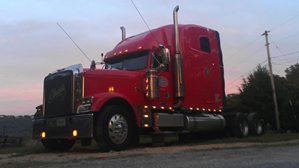It is a long held belief that any lights that are installed on a commercial motor vehicle, particularly truck manufacturer installed lights, must be capable of operation, day or night. More often than not, old school drivers know this to be true, the young drivers they are training are taught this to be true and many mechanics believe this to be the law, including those who are inspectors performing the DOT required annual Periodic Inspection. Indeed, many law enforcement officers will issue a citation for any light on a CMV that is not operable.
 |
| *Image courtesy of Freightliner truck driver Nick Neeley |
The real truth lies within the federal regulation located at Title 49, Part 393, Subpart B. All of the required lamps for each class of CMV are located in Table 1 of §393.11. Any lamp not shown in Table 1 is, therefore, not required. This would include fog lights, running lights, chicken lights, decorative or other accessory lighting.
Paragraph 393.9(a) states: “All lamps required by this subpart shall be capable of being operated at all times. This paragraph shall not be construed to require that any auxiliary or additional lamp be capable of operating at all times.” This regulation is one of the rare regulations that not only state a requirement, it tells us what lights are not required.
Why is this information important? Mechanics certified to perform Periodic Inspections have been known to fail the inspection because of an inoperative non-required lamp. Of course you could receive a pass after the shop charges the driver an obscene amount to replace a burned-out lamp. Worse yet, an ill-informed law enforcement officer might cite you for an inoperative fog light during a level I roadside inspection. This would not only result in a fine, the logging driver would receive 2 CSA points on the driver’s score and the carrier would get the 2 CSA points applied to the carrier rating. The fine may stick but now that you know that the inoperative fog light does not violate a federal regulation, you may challenge the CSA points using the DataQ process at dataqs.fmcsa.dot.gov.
My comments aren’t to suggest that a driver should not worry about an inoperative lamp. Any obvious defect, violation or not, is a conspicuous invitation for a diesel cop to inspect the truck for other defects that could lead to an out of service order.
The above comments refer to federal regulations only. Some states may require any or all accessory lights to be operable; this would be covered under the FMCSA regulation at paragraph 392.2 which requires a CMV operator to comply with regulations of the jurisdiction in which the CMV is operated.
*This article was submitted to us by a Team Run Smart member in the Truck Forum. Do you have an article that you would like to submit for consideration to be published on Team Run Smart? Email admin@teamrunsmart.com with your article or suggestions for future content. And make sure to come back to the Forums on Team Run Smart to stay ahead of the trends and in on the conversations to help run your business smarter.